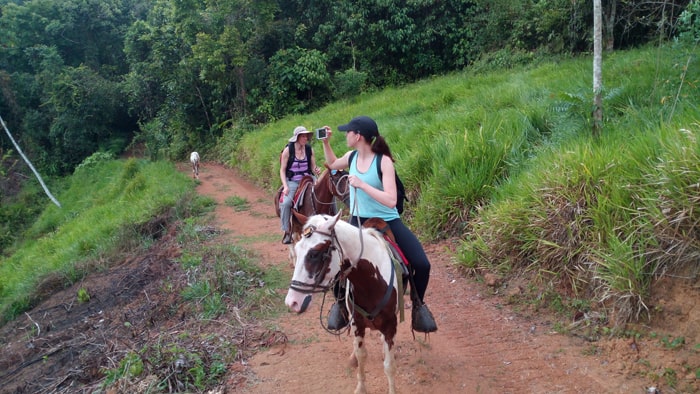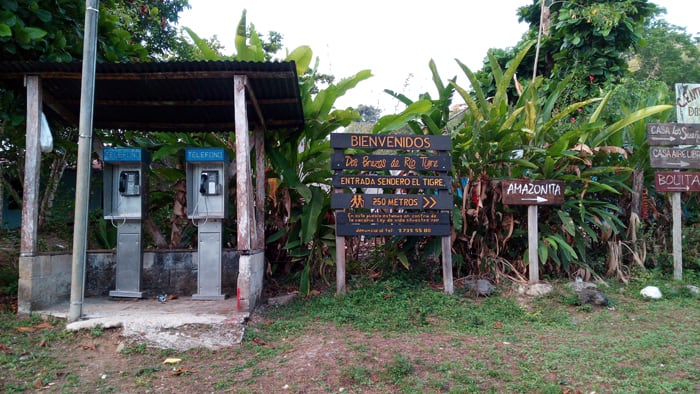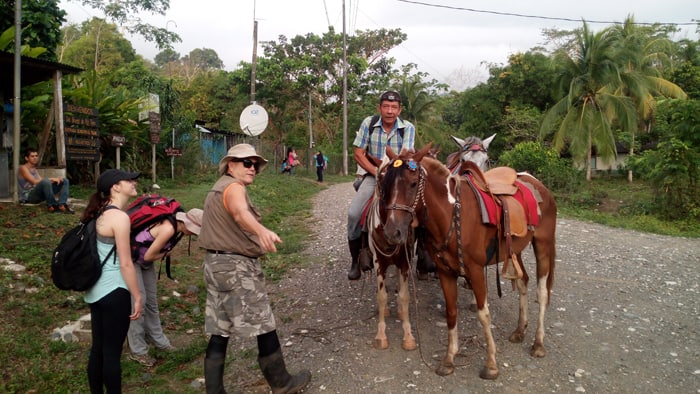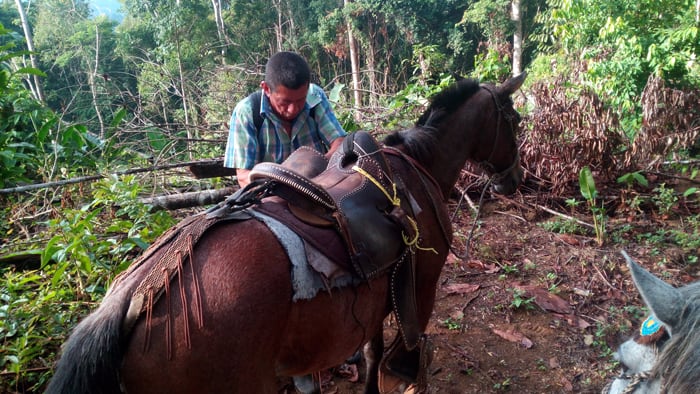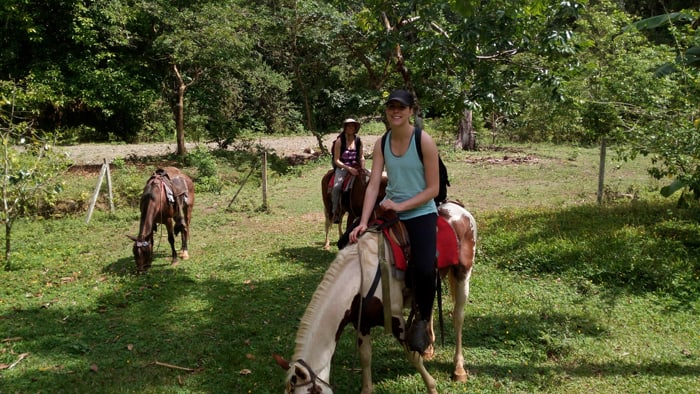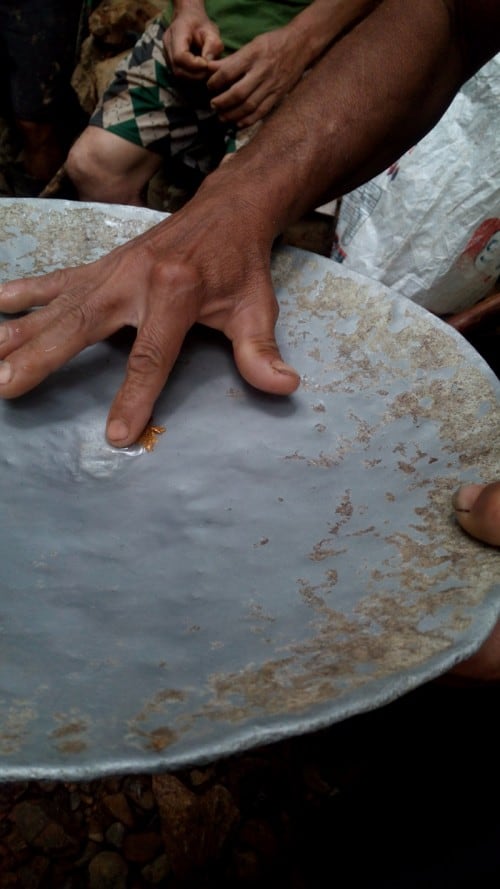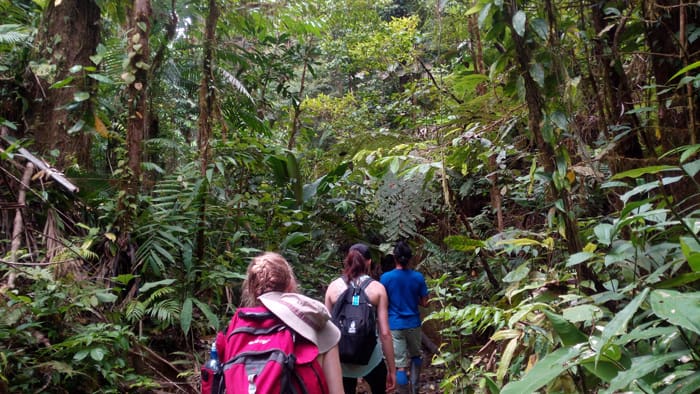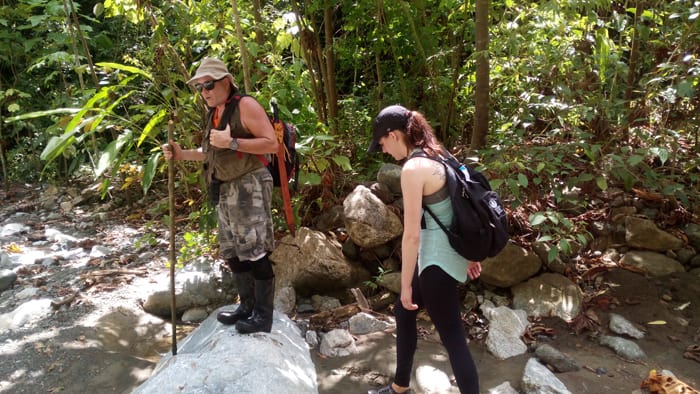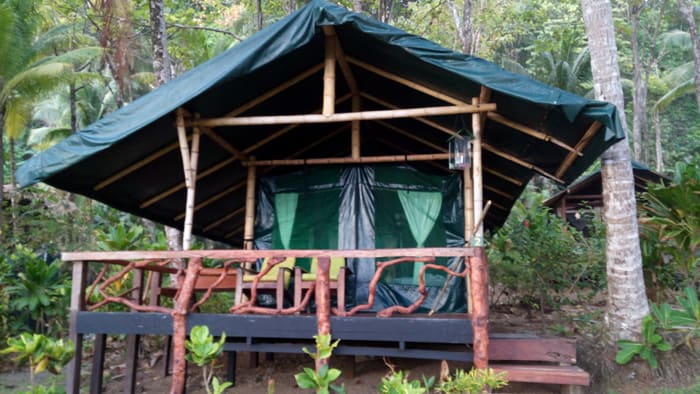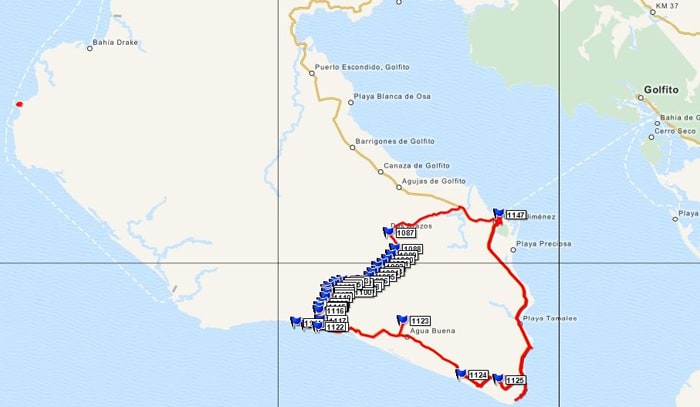CARATE, Puntarenas — What has 4 wheels, 24 hooves, 8 legs, takes 9 hours and covers 32 kilometers? The mother of all adventures, that’s what.
Our plan: Drive from Puerto Jiménez, on the eastern side of the Osa Peninsula, to Dos Brazos del Río Tigre, about 20 minutes away; mount horses and ride four or five hours to Quebrada Piedras Blancas, a creek halfway across the Osa; then embark on the “Bataan death march” — a grueling walk to Carate on the Pacific Ocean, also four or five hours, to the top of a steep ridge and back down again.
If we survived that, we just had to walk 3km along the beach to La Leona Lodge and collapse.
The taxi was supposed to come at 5:15 a.m., but it honked at 5:06 a.m., when most of us were still wolfing down scrambled eggs (on our feet). Four of us piled in: my friend Cindy, her daughter Mia, my brother Paul and me. (Murphy, Cindy’s husband, opted to stay home in the air-conditioned house and watch CNN, as if to catch international news of four missing hikers in Costa Rica.)
After the 13km taxi ride, Don Gerardo showed up in Dos Brazos with five saddled horses and a nursing colt, and we mounted up for the ride. Usually on horseback tours the guide assesses the riders’ experience and matches them up with the most appropriate mount, but in this case Gerardo just said, “This one’s ready,” and indicated that the nearest person should saddle up.
Consequently our youngest adventurer, 23-year-old Mia, mounted the one fierce young stallion (Paul and I both advising her against mounting from the right), while the rest of us climbed aboard tired old geldings and mares.
Mia’s beast quickly snapped at another horse, and Gerardo said, “Be careful, that one bites,” noting that if it bites the other horses they could rear and throw us. He indicated which horses it liked to bite (the other three males, all of which were gelded except for the riderless pony, who came along for the milk).
“That’s the spare,” Gerardo said, indicating the pony. “If one of these collapses, we’ll ride that one.”
I couldn’t remember the name of my horse, but I soon dubbed him Sir Trots-a-Lot, because he would suddenly take off at a trot or a gallop whenever he felt like it. And yet there were times when he stopped and wouldn’t budge, or he huffed and puffed and staggered and slipped like the world’s oldest horse.I was walking along with Paul and Gerardo when my horse suddenly took off running, and Gerardo said, “Es un poco loco.” Poco Loco would also be a good name for him, I thought.
The rain forest we were riding through was pristine and beautiful, and we saw toucans, macaws and white-faced monkeys. This horseback/hiking plan of ours is basically unknown to tourism, and Paul claims to be its discoverer — having done it twice before, in both directions.
The beauty of it is that it skirts the edge of Corcovado National Park, so you see the same nature without being required to hire a guide or pay an entrance fee.
Gerardo, who has a company called Cabalgata La Ponderosa that offers horseback riding around Dos Brazos, confirmed that he almost never takes tourists this far because the road is too long.
After about four hours of riding, we came to a finca that offers overnight lodging to tourists who undertake this trek on foot. This is one of the tours Paul offers through his travel agency in Puerto Jiménez, Osa Corcovado Tour and Travel, which operates out of his Internet café, CafeNet El Sol. He calls it the Sendero El Dorado, the Golden Trail, because it follows one of the most productive gold-mining rivers from the gold rush of the 1980s.
We needed to find a guide to take us from the place where the horses could go no further to the trail that led to Carate. The master of the finca volunteered his son Henry, who was happy to oblige.
Henry put on long socks and rubber boots and led the way, walking alongside our horses up the river, Quebrada Piedras Blancas, or White Rocks Creek.
Henry was an orero, a gold miner, lean and long-haired and kind of hunky. We all noticed when young Mia broke out the first Spanish we had heard from her: “Cuantos años tienes?”
“Veintiocho,” he said. I was surprised he didn’t ask her the same question. Later we teased 23-year-old Mia about her interest in our handsome guide.
Henry led us along the creek that forms the border of Corcovado National Park, a side of it that few tourists ever see.
We stumbled upon three gold miners working the creek who had set up an impressive wall of rocks to control the flow of water and enable them to dig in the river bottom and pan it for gold dust, flakes and nuggets.
Paul recognized one of the guys and chatted them all up in his perfect Tico Spanish. The oldest and most talkative of the miners offered to sell us some gold (at prices that Paul dismissed as inflated), and he poured the contents of a little plastic capsule into a gold pan.
There was one impressive little nugget that the guy picked up and threw into the pan so we could hear its loud clink.
Paul asked them if they’d heard the latest news about the drug plane that crashed in the ocean off Carate on Tuesday. They had, but the rumors reaching Paul’s ears were fresher. He said a plane arrived over Carate to make an illegal night landing where it was supposed to meet a truck packed with 300 kilos of cocaine and 2.5 million euros.
But the truck was late, and the plane apparently circled over the area until it ran out of gas and crashed in the ocean. The dead pilot’s body was recovered and the copilot’s was apparently lost at sea.
So the late drug truck turned around and hauled ass in the only direction it could, back to Puerto Jiménez, on the coastal road that runs down one side of the peninsula and up the other.
By then the cops had caught wind — and by pure coincidence there were a huge number of cops in Jiménez for a desalojo — an eviction of squatters just north of town. The day before I had driven through Jiménez and saw something like 10 police trucks parked around the police station, when there were usually one or two.
So now the chase was on, and the drug guys ditched their truck in a neighborhood on the other side of the BM supermarket (yes, the supermarket is called the BM) — and it just happened to be a property that Paul’s real estate company was trying to sell.
By further coincidence, one of Paul’s workers was scheduled to show the property that very day to some prospective buyers, and they showed up to find the place cordoned off with police tape! Paul guffawed at the irony of the timing.
After 20 minutes or so we moved on, and I reminded myself to make some mental notes about all the nature I had come here to see. That part was truly spectacular — even while walking up a riverbed, we were almost completely covered overhead by the jungle canopy, engulfed on all sides by pure green.
It’s like a green cathedral, I thought, as there’s something spiritual about a close encounter with such pristine wilderness.
Our guided hike was up, marked by two pink flags tied to two trees that marked the gateway to an uphill trail that would lead straight to Carate. Here Henry would be leaving us.
“¿De aquí no hay pérdida?” Paul asked, meaning, “From here you can’t get lost?”Henry smiled, shook his head and said from here you can’t get lost.
We took pictures, gave Henry ₡13,000, shook hands all around, and set off on our own.
We labored to climb to the top of a ridge, and from there we could almost see just how much of a vertical drop we had left.
We stopped to eat box lunches we had bought (surprise: rice, beans and chicken), sitting in the leaves with the ants because we couldn’t find logs.
It was all downhill from there, but it was an extremely steep downhill that Paul accurately described as “technical.” It wasn’t hard cardio — I noticed that we were all breathing through our noses — but we were choosing our steps as if negotiating a minefield in Chechnya.
Paul, Cindy and I all had walking sticks, and I would say these are essential, though Mia walked down the ridge without one just fine. I slipped and fell three or four times, and I occasionally asked myself, Why are we doing this? Oh yeah, because adventure.
Our long downhill slog finally ended in a creek, which I oddly recognized because it was just outside Luna Lodge, where I stayed with my son Jordan just four months ago.
We found our way to the Río Carate and followed it downstream, then found a road and, finally, civilization. Paul had told us there was a store in Carate where we could buy Cokes or beers, but as luck would have it, it was closed. We sat down and applied sunscreen for the 3km slog along the beach to our lodge. (There’s actually a shady trail higher up, but Paul didn’t know about it.)
My shoulders were aching from the weight of my backpack, but I managed by pulling the straps off my chest with my hands. I had brought three liters of water, which turned out to be twice as much as I needed, and by now it felt like I was carrying gold bricks.
At long last we arrived at our destination, La Leona Lodge, a lovely spot right on the ocean where the rooms are tents on platforms, with open-air bathrooms inside. After a complimentary strawberry drink at the bar, we showered, collapsed and napped.
When I woke up I found Paul sitting on a little bluff overlooking the pounding ocean, drinking a beer and reading “A Dance With Dragons.” I treated myself to a piña colada and joined him.
“I’m sore in places I didn’t know I had places,” I said.
IF YOU GO
Getting there: This adventure, including taxi, horseback ride with Cabalgata La Ponderosa and lodging at La Leona Lodge, can be booked with Osa Corcovado Tour and Travel. (Full disclosure: My brother owns this company.) Call the office at 2735-5719, or for English call Vanessa at 8632-8150.
What to bring: Long, lightweight pants, hiking boots or rubber boots, hat, water, lunch, bug spray, sunscreen, cash for tips.

